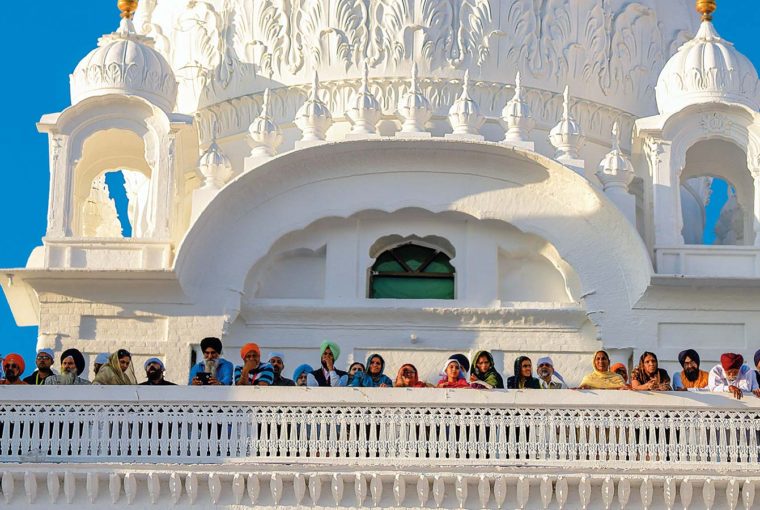At one point, it was unimaginable. Now it’s a reality. Ironic that 30 years to the day the Berlin Wall fell, which also coincided with the 550th birth anniversary of the first guru of Sikhism, the Kartarpur Corridor, a 4-kilometer journey that has taken 72 years in the making, was inaugurated and made open to Sikh yatris from across the border to travel to one of their holiest sites, Gurdwara Darbar Sahib, in Narowal district, Pakistan, completely visa free. Dubbed as the “peace corridor”, the opening of the passage was a great diplomatic first, one that proved to be a unique experiential journey for journalist Yusra Askari as she witnessed history in the making.

As I arrived in Lahore on the eve before the big day, the city was buzzing with activity. The mood was celebratory and everyone seemed to be in preparation mode to mark the great diplomatic first that, like never before, would enable Indians to visit Pakistan, visa free! Scores had arrived from far and wide to witness the opening of the Kartarpur Corridor that coincided with the 550th birth anniversary of the first guru of Sikhism and the energy was palpable. Most if not all hotels were packed to maximum capacity with Sikh yatris [pilgrims] not only from across the border but also from around the globe, all wanting to be part of history in the making.
09.11.2019 was due to be a long and eventful day. On assignment to document the inaugural, I was accompanied by photo-journalist Mobeen Ansari. We were to gather at the Park Lane Hotel in the heart of Gulberg to join over 50 mostly Indian media-folk being driven up to Gurdwara Darbar Sahib Kartarpur Sahib at an almost three-hour distance from Lahore. Breakfast call was set for 6:30 am and the scheduled time for departure for 7:00 am.
We walked into the lobby to find the open-plan dining area packed to the brim. A cascade of multi-colored dastaars [turbans] suddenly gave new life to a drab and chilly autumn morning. To the left, a lavish buffet was where the majority were huddled. It was nice to see that a predominantly meaty spread had very thoughtfully been redesigned to meet vegetarian requirements. And as the numbers swelled, tables were turned over swiftly with occupants being changed every few minutes.
Inexplicably, the day ran late and it was around two and a half behind the scheduled departure time that we found our way into several buses part of a large convoy that included a heavy security detail, ambulances and even a fire-engine.
Just past 10:00 am, bottled water, juice packs and bags of crisps in hand, we embarked upon the journey of a lifetime. The terrain we travelled through was diverse – the cityscape soon turned into the lush countryside as we drove on through small towns towards our destination. As we inched closer, the gurudwara stood tall from a long distance. Despite the hazy skies, the pristine white of the complex glistened bright in the early afternoon sun.
As our bus began to approach the front flank of the building, the excitement on-board multiplied. We drove past queues upon queues of festively clad yatris to arrive at the main entrance. Just past the wrought-iron filigree gate, stood the newly constructed gurdwara complex in all its glory, that in just about 10 months went from an expanse of 4 to 42 acres- to now include a new courtyard, museum, library, dormitories, locker rooms, an immigration centre and an embankment to protect the shrine from floods.
With our heads covered and phones with close to zero cellular signals in hand, through the arches of the four-minaret gateway, we entered the compound where stands Guru Nanak Dev ji’s final resting place.
The atmosphere was carnivalesque. The entrance foyer of the gurudwara was filling up swiftly. While some chose to catch a quick glimpse of an architectural model of the newly constructed complex and its planned expansions, most were quick to surrender their shoes in exchange for a bright green plastic token to begin their barefoot walk into the courtyard.
We too were among the latter. Through the corridor, past the grassy patch and down the steps stood Gurdwara Darbar Sahib Kartarpur Sahib. The presence of the age-old structure was all and more than what I had imagined it to be. As I dipped my feet into the charon ganga, a channel of water that flanks the periphery of the courtyard, I couldn’t help but look up in awe.
The stark yet beautiful contrast of the ivory expanse frosted over with pops of colour, was a sight to see. In the courtyard, angled in front of the stage, the farshi baithak or floor seating arrangement was densely dotted with cushions in every imagineable colour – most already occupied by pilgrims early in the day.
As first-time visitors, we explored the grounds to get a feel of the place. Interacting with the yatris set the pace. Families thronged to and around Guru Nanak’s red-brick well, dousing themselves with the holy waters. Some even bottled a few milliliters to take back home. For me the parallel was instant – the well waters of Gurudwara Kartarpur Sahib were to the Sikhs what aab-e-Zamzam [water from the Well of Zamzam in Mecca] is to Muslims – revered. While interacting with pilgrims at the well, someone very kindly pointed us in the direction of the Langar Hall, not too far from where we were. Time for some much-needed sustenance; a delicious all vegetarian spread of sarson ka saag (mustard greens), mixed subzi (vegetables), maash ki daal (white lentils), rice and bread topped off with hot gulab jamuns and jalebi. The meal was prepared in-house by the gurdwara’s newly revamped state of the art community kitchen and served without charge to all the visitors – religion, caste, gender, economic status or ethnicity, no bar.
Lunch done, as we tried to make our way back to the central courtyard, we chanced upon a little girl who was evidently lost. She was crying hysterically but silently and despite several attempts to get her to retrace her path or tell us her own or her parents’ name, we made no headway.
Unwilling to leave the child and move on, we took it upon ourselves to ensure she found her family. We trailed through the complex, regrettably to no avail. Security personnel suggested we make our way to the stage and have an announcement made. That appeared to be the only option.
As we reached midway through the courtyard, two little turban-donning, leather jacket-clad, under 10-year-olds made their way to us. The little girl’s frown suddenly turned into a smile even though she continued to cry. The boys were evidently her older brothers but we wanted to hand over the little girl to no one other than her parents.
As the two boys led us in the direction of their mother, in a few moments 6-year-old Arleen Kaur was reunited with her family. As she hugged her mother’s leg and cried inconsolably, her identically dressed twin sister looked on in surprise. Arleen’s mother told us that the little girl had somehow drifted away from her family and gotten lost in the crowd. However, all’s well that ends well.
Moving on, we walked in the direction of the Mazar Sahib, the burial site of Guru’s remains and it was here that we were caught in the midst of a sudden frenzy. The first ever jatha or group of pilgrims from across the border to have made its way to Pakistan via the Kartrapur Corridor had arrived. The over 600 strong Indian contingent comprised largely of politicians from both the treasury and opposition benches of the Government of Punjab.
With a bare to minimum security escort accompanying them, seen milling with the crowd, paying their respects to the Guru were the likes of the 87-year-old former Prime Minister of India, Manmohan Singh and the 93-year-old veteran politician Prakash Singh Badal. Also, in attendance; the Chief Minister of Punjab, Captain Amarinder Singh, federal ministers Hardeep Singh Puri and Harsimrat Kaur, as well as the very popular former crickter and now MP, Navjot Singh Sidhu and actor turned politician Sunny Deol.
As the Indian visitors made their way into to the main prayer hall, we too followed suit. The three-storied structure that houses some of the most important chapters in the history of Sikhism, echoed with the sound of shabad kirtan [hymns]. On the ground floor while some pilgrims rested, most were deep in prayer as they paid their respects at the Samadhi Sahib – the site where the Guru’s remains were cremated.
A circular staircase lead us up to the first floor where pilgrims looped around the central hall, waiting patiently in line to pay their respects before the ‘Palki Sahib’ where lie the scriptures of Guru Granth. Under the fuchsia awning, the gold palki (palanquin) shone bright as the granthi [priest] sat behind it reciting religious verses while a lady continued fanning the chavar sahib.
As the melodies of the raagi or kirtania as they are also referred to, echoed loud, devotees bearing offerings of beautifully embroidered poshaks (garb) or rumalas (handkerchief) and boxes of mithai (traditional sweets) as offerings, paid their respects with their hands folded and their heads bowed to on their way out be honoured with a saroopa in return for their service. And not to forget the fistful of karha prasad – a delicious mix of flour, ghee and sugar which as a sign of humility and respect, is accepted with hands raised and cupped.
The second floor of the gurdwara opens up on to the roof – this is where the sukh asaan asthan is located but unfortunately on the day it was closed to visitors. Looking down at courtyard from a height, one knew there was plenty to celebrate – the warm glow of the late afternoon sun, provided the ideal setting for the moment it would all be official.
As we made our way back down to the courtyard, Prime Minister Imran Khan’s address was about to begin. Ironic that 30 years to the day the Berlin Wall fell, the Kartarpur Corridor, a 4-kilometer journey that has taken 72 years in the making, was inaugurated and made open to the public. In removing the barriers towards people to people interaction, with this peace\ corridor, Pakistan and India have collectively made not only for decades of hostilities to unravel but also to reduce mistrust and generate goodwill. At the moment, PM Khan declared open what has now been termed the ‘peace corridor’, a curtain of diaphanous yardage with green, white and red balloons atop it, symbolically ascended to skies above the inaugural kirpan shaped plaque it was shrouded through the day – a visual metaphor that is hopefully indicative of a less hostile regional relationship to come. Jee ayaan nu – welcome to Pakistan!





